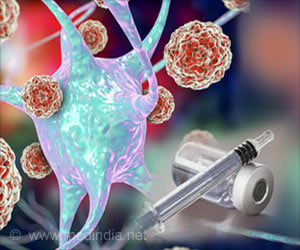
‘The enzyme PI5P4K-946 (phosphatidylinositol-5-phosphate 4-kinase-946) acts like the arrow on a fuel gauge. It senses and communicates (signals), via a second messenger, the amount of GTP fuel that is available to a cell at any given time.’
Tweet it Now
Sasaki and fellow researchers showed that the enzyme PI5P4K-946 (phosphatidylinositol-5-phosphate 4-kinase-946) acts like the arrow on a fuel gauge. The enzyme senses and communicates (signals), via a second messenger, the amount of GTP fuel that is available to a cell at any given time. Until now, the molecular identity of a GTP sensor has remained unknown. Sasaki said, "Energy sensing is vital to the successful proliferation of cancer cells. A large amount of GTP is required in rapidly dividing cells, and cells need to know that the fuel is available to them. If we can interfere with the ability of PI5P4K-946; to sense fuel availability and communicate that information, we may be able to slow or halt the growth of cancers, including the aggressive brain cancer glioblastoma multiforme and cancers that have metastasized to the brain."
The publication in Molecular Cell is Sasaki's first to address PI5P4K-946; as a molecular sensor of GTP concentration. Initially, he and his team faced skepticism regarding the existence of GTP energy-sensing; however, with a pilot grant funded by Cincinnati's Walk Ahead for a Brain Tumor Cure and other local sources, the researchers were able to pursue their high-risk research and acquire enough promising data to earn a five-year, $1.67 million grant from the National Institutes of Health in 2014.
Ronald Warnick, medical director of the Brain Tumor Center and the John M. Tew, Jr., Chair in Neurosurgical Oncology, said, "The publication in Molecular Cell is another milestone for Atsuo Sasaki and the UC Brain Tumor Center. The seeds of this discovery, which were planted locally by friends of the UC Brain Tumor Center and nourished by federal tax dollars, are now bearing their first fruit as we gain a better understanding of cancer's energy mechanisms."
Sasaki and his team identified PI5P4K-946; as a GTP sensor by demonstrating, in a laboratory setting, its ability to bind to GTP and by demonstrating, at the atomic level by X-ray structural analysis, the molecular mechanism by which it recognizes GTP. They then designed PI5P4K-946; mutant cells that were unable to sense GTP concentration and, as a result, impaired the ability of PI5P4K-946; to promote tumor growth.
Advertisement
Sasaki said, "By unveiling PI5P4K-946;'s role as a GTP sensor, we now have a potential new therapeutic target for patients. If we can find drugs that stop PI5P4K-946; from acting as the fuel indicator, we could get these aggressive and tragic cancers into energy-depleted status."
Advertisement















